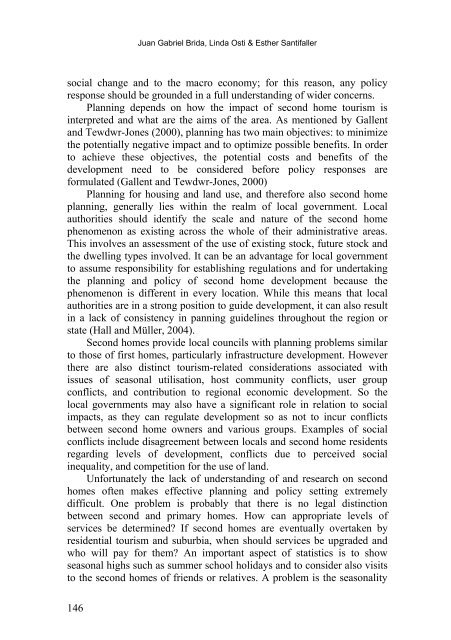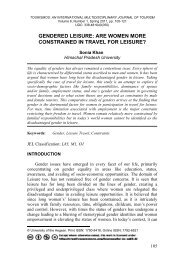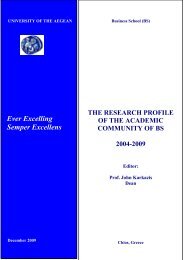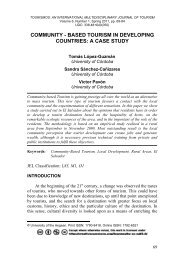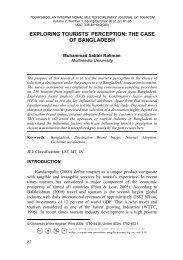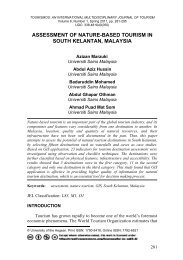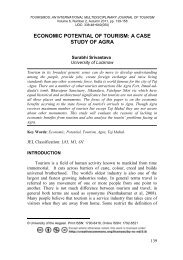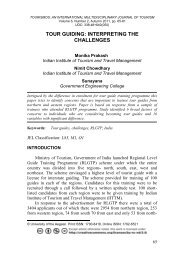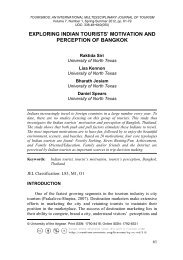TOURISMOS is an international, multi-disciplinary, refereed (peer ...
TOURISMOS is an international, multi-disciplinary, refereed (peer ...
TOURISMOS is an international, multi-disciplinary, refereed (peer ...
You also want an ePaper? Increase the reach of your titles
YUMPU automatically turns print PDFs into web optimized ePapers that Google loves.
Ju<strong>an</strong> Gabriel Brida, Linda Osti & Esther S<strong>an</strong>tifaller<br />
social ch<strong>an</strong>ge <strong>an</strong>d to the macro economy; for th<strong>is</strong> reason, <strong>an</strong>y policy<br />
response should be grounded in a full underst<strong>an</strong>ding of wider concerns.<br />
Pl<strong>an</strong>ning depends on how the impact of second home tour<strong>is</strong>m <strong>is</strong><br />
interpreted <strong>an</strong>d what are the aims of the area. As mentioned by Gallent<br />
<strong>an</strong>d Tewdwr-Jones (2000), pl<strong>an</strong>ning has two main objectives: to minimize<br />
the potentially negative impact <strong>an</strong>d to optimize possible benefits. In order<br />
to achieve these objectives, the potential costs <strong>an</strong>d benefits of the<br />
development need to be considered before policy responses are<br />
formulated (Gallent <strong>an</strong>d Tewdwr-Jones, 2000)<br />
Pl<strong>an</strong>ning for housing <strong>an</strong>d l<strong>an</strong>d use, <strong>an</strong>d therefore also second home<br />
pl<strong>an</strong>ning, generally lies within the realm of local government. Local<br />
authorities should identify the scale <strong>an</strong>d nature of the second home<br />
phenomenon as ex<strong>is</strong>ting across the whole of their admin<strong>is</strong>trative areas.<br />
Th<strong>is</strong> involves <strong>an</strong> assessment of the use of ex<strong>is</strong>ting stock, future stock <strong>an</strong>d<br />
the dwelling types involved. It c<strong>an</strong> be <strong>an</strong> adv<strong>an</strong>tage for local government<br />
to assume responsibility for establ<strong>is</strong>hing regulations <strong>an</strong>d for undertaking<br />
the pl<strong>an</strong>ning <strong>an</strong>d policy of second home development because the<br />
phenomenon <strong>is</strong> different in every location. While th<strong>is</strong> me<strong>an</strong>s that local<br />
authorities are in a strong position to guide development, it c<strong>an</strong> also result<br />
in a lack of cons<strong>is</strong>tency in p<strong>an</strong>ning guidelines throughout the region or<br />
state (Hall <strong>an</strong>d Müller, 2004).<br />
Second homes provide local councils with pl<strong>an</strong>ning problems similar<br />
to those of first homes, particularly infrastructure development. However<br />
there are also d<strong>is</strong>tinct tour<strong>is</strong>m-related considerations associated with<br />
<strong>is</strong>sues of seasonal util<strong>is</strong>ation, host community conflicts, user group<br />
conflicts, <strong>an</strong>d contribution to regional economic development. So the<br />
local governments may also have a signific<strong>an</strong>t role in relation to social<br />
impacts, as they c<strong>an</strong> regulate development so as not to incur conflicts<br />
between second home owners <strong>an</strong>d various groups. Examples of social<br />
conflicts include d<strong>is</strong>agreement between locals <strong>an</strong>d second home residents<br />
regarding levels of development, conflicts due to perceived social<br />
inequality, <strong>an</strong>d competition for the use of l<strong>an</strong>d.<br />
Unfortunately the lack of underst<strong>an</strong>ding of <strong>an</strong>d research on second<br />
homes often makes effective pl<strong>an</strong>ning <strong>an</strong>d policy setting extremely<br />
difficult. One problem <strong>is</strong> probably that there <strong>is</strong> no legal d<strong>is</strong>tinction<br />
between second <strong>an</strong>d primary homes. How c<strong>an</strong> appropriate levels of<br />
services be determined? If second homes are eventually overtaken by<br />
residential tour<strong>is</strong>m <strong>an</strong>d suburbia, when should services be upgraded <strong>an</strong>d<br />
who will pay for them? An import<strong>an</strong>t aspect of stat<strong>is</strong>tics <strong>is</strong> to show<br />
seasonal highs such as summer school holidays <strong>an</strong>d to consider also v<strong>is</strong>its<br />
to the second homes of friends or relatives. A problem <strong>is</strong> the seasonality<br />
146


